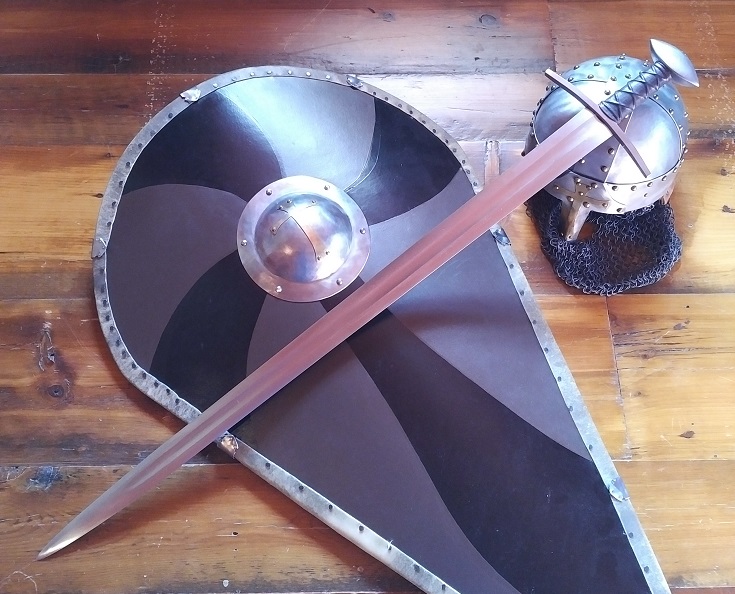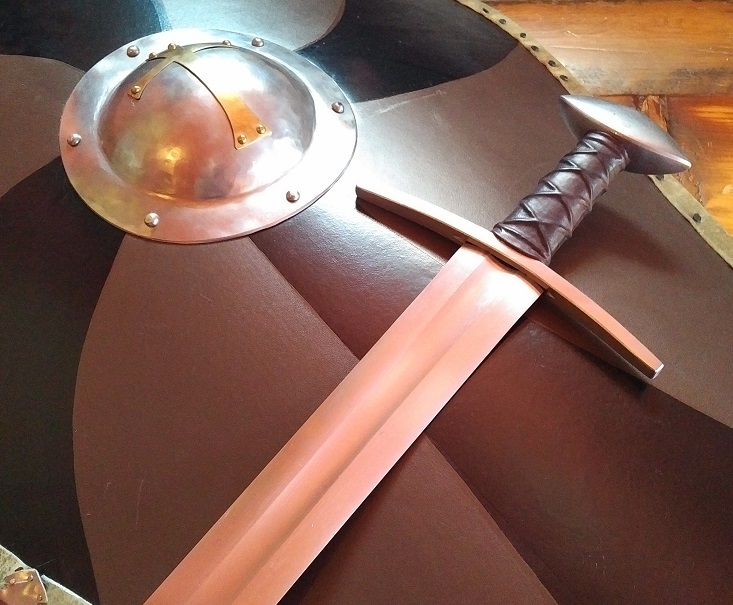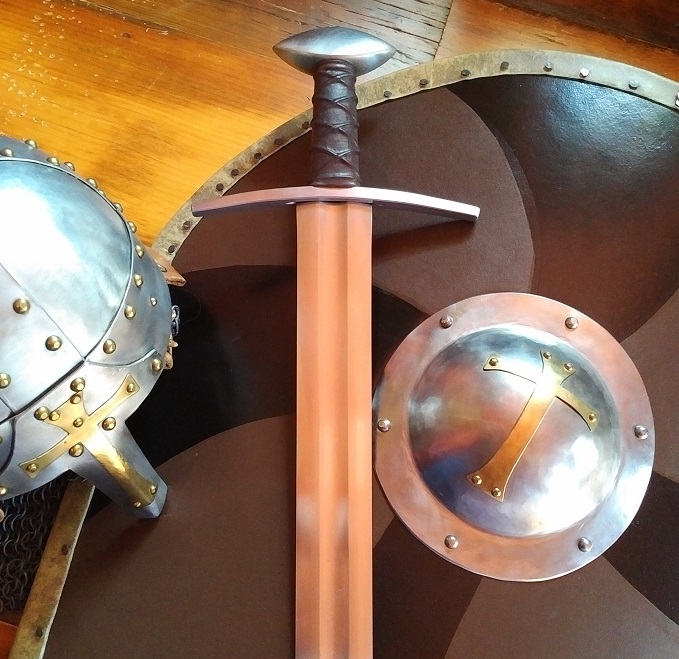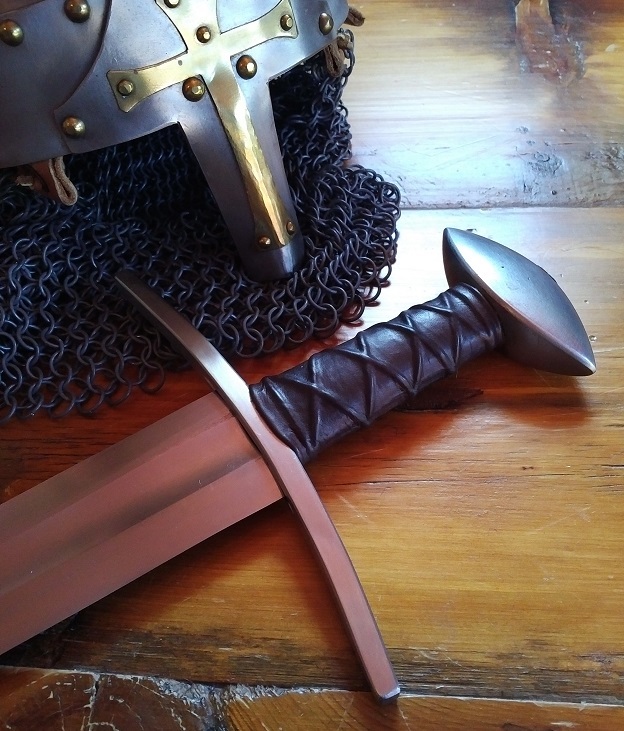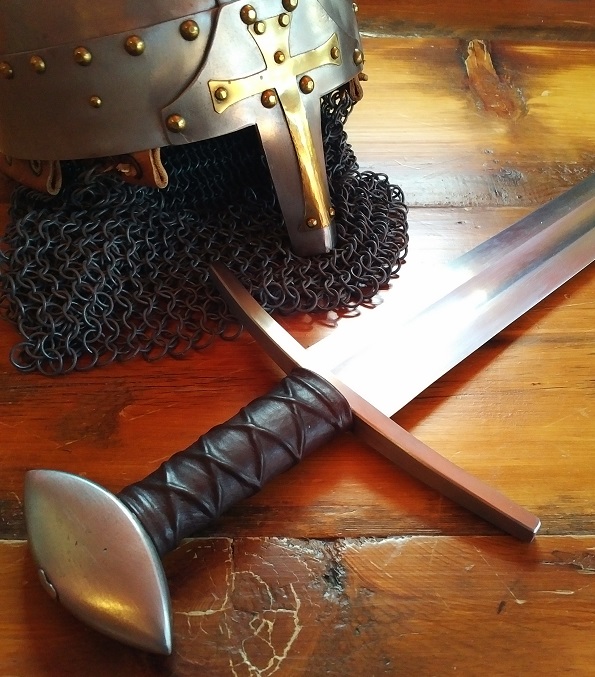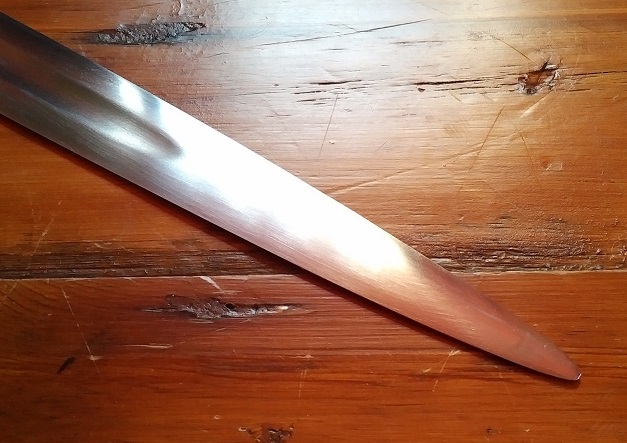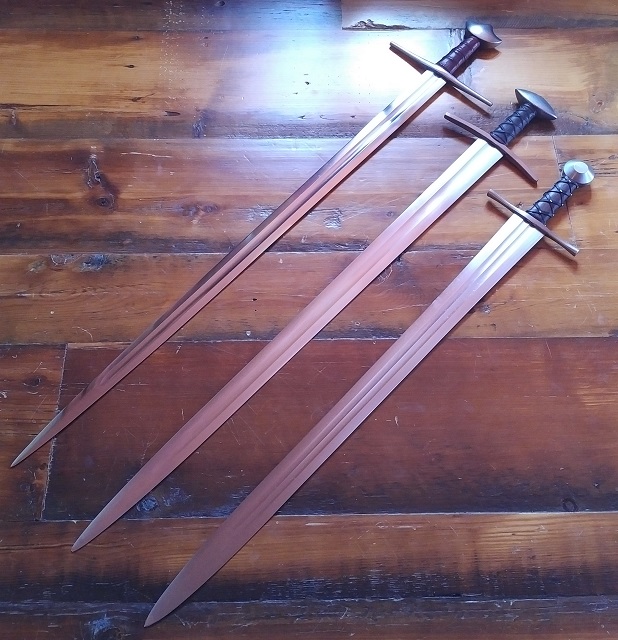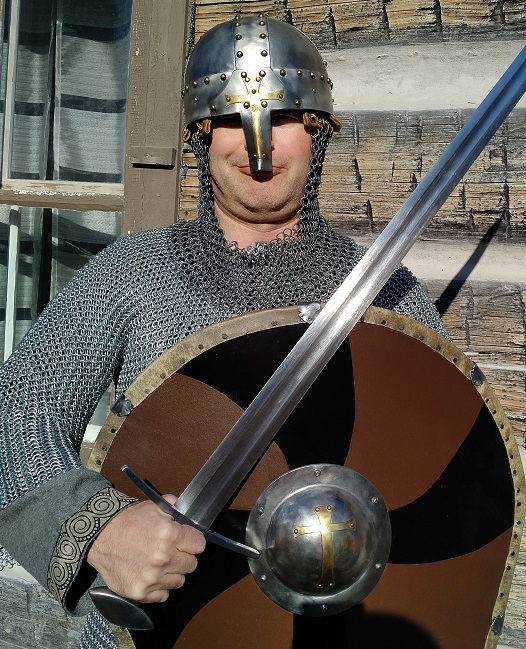As the time of the Viking ‘marine’ transitioned to the period of mounted, well-armored knight, various innovations appeared in swords: larger versions of the broad-bladed, broad-fullered Oakeshott type X sword with cruciform hilts, longer more slender type XI swords with narrow fullers, and an intermediate form that Oakeshott called Xa (see comparison picture below). This type was perhaps the archetypical weapon of the early/high medieval warrior, and is the subject of the current review.
The particular sword that inspired this commission appears to be in a private collection. In some ways it’s quite typical of a 12th century Xa: wide Brazil nut pommel (type A) and longish 35” blade. In a few ways though it is slightly unusual: it has a slightly curved cross, a longer than normal grip, and rather pronounced profile taper, which seems to promise nice handling properties. The fuller starts wide (almost X width) but then narrows along with the blade. Indeed, it might have been an early XII if the fuller were a bit shorter, but transitional forms between Xa and other types are not rare.
A picture of the original word, along with the initial design of its replica, can be seen here: http://myArmoury.com/talk/files/comparison_and_design_371.png
The Commission
Maciej Kopciuch, a practitioner of traditional sword-making techniques based in Poland, has come on strong as new presence in the swordsmithing community over the past 2-3 years. Appreciating his approach and the type of swords that he prefers, I was looking for a job to give him and this sword seemed a natural fit. Not only was it in his ‘wheelhouse’, he had a picture of it in his original web-site! So it seemed pre-destined. After some discussion (leading to his design shown in the link above) I gave him the green light and a down payment. I asked him to stick with the original dimensions, with a few minor deviations: I choose to shorten the grip to suite my hand size, we forewent the extensive inlay of the original (except I asked for a bronze-inlayed cross potent), and I recall Maciej saying that he wanted to make the pommel heavier to improve balance. I ordered this sword with close-to-sharp, but not sharp edge, because I want to use it for dry-handling exercises with less risk of self-injury.
There were a few starts and stops on this project, as Maciej has acknowledged elsewhere. In particular, the first version was a perfectly good sword but did not have the dimensions that I asked for. But Maciej was friendly and communicative throughout the process. And after a little more than a year (rather typical for custom jobs) I received the final product. It came in adequate packaging, secure but not the heavy wooden crate that some people use. As a bonus, the shipping from Poland to Canada was very quick (about a week) and I did not have to pay any customs taxes.
Maciej has pictures of the sword on his web-site (‘Norman Rider Sword’) and the full story of the development of the sword can be viewed here: http://myArmoury.com/talk/viewtopic.php?t=32913
Since Maciej’s work is not as well known, I will sometimes make comparative references to well-established brands (Albion, Arms and Armor, Del Tin) to describe his work.
Product Overview
Maciej’s measurements, which seem correct, are as follows:
Overall length 1035mm
Blade length 889mm
Grip length 94mm
Blade width 51mm
Thickness: at the base 4,5mm
Pommel 90x35x27mm
Balance ca. 185mm
Weight ca. 1206g
This final version of the sword (as pictured below), comes out quite near to the original with the deviations originally agreed to. As a fan of such sword types, I find the design and execution to be quite elegant, indeed beautiful. There is an economy of form here that would fit quite well in the Albion line – with perhaps one exception noted below-- there is not an extra gram unnecessary of steel e on this piece. This applies to both the blade and the cross (which is often overbuilt in entry level brands). Everything is shaped right, including the pommel and distal taper in the blade, which will influence my following comments on handling. One perplexing detail is that the inlay seems to have disappeared. I saw a picture of an early version with an engraved cross in the fuller, but see no evidence of it here.
Handling and Performance
I can really only talk about handling here, and speculate on cutting performance, because I have not used it for contact and am not one to engage in destructive testing. What I can say is that, given the forward-balanced nature of this type –clearly designed for use from the back of a horse— the handling is…sweet! I had heard in the past that Maciej’s swords tend to be a bit heavy and sluggish compared to Albion, but this is not the case here. This sword is quite easy to hold both statically (the grip size and pommel shape perfectly allows the use of leverage against the blade), and dynamically, where it accelerates, flows, and stops quite easily (for a sword of this type). Clearly this is because, despite the forward balance, the combination of profile taper and distal taper provide excellent mass distribution. I have handled many swords of this type, and cannot recall one that felt better. This is aided by the well-shaped grip with tactile leather wrap and ‘XXX’ underwrap…a style that I requested and which Maciej apparently has come to appreciate as well.
The blade is relatively stiff for its length and thinness, and not particularly prone to vibrations, but the proximal harmonic node is a bit far down the handle for my taste. I like it at the index finger (I tend to grip the handle tightly between the index finger and thumb and leave the other fingers looser) and this is a bit further down, but ‘no biggie’. I suspect this related to the heavier pommel than the original (those guys knew what they were doing!).
As far as I can tell, the blade has a good temper but I simply don’t know how hard it is or how it would hold up compared to the established brands, which sometimes use industrial heat treat. It would certainly be interesting to do the types of tests they do on ‘Forged in Fire’, but I won’t be doing that. I might, however, try it on some water bottles. I think it will get up to enough velocity to cut well even without a sharpened edge.
Fit and Finish
The fit is all even, symmetric, and tight, including the leather wrap. But when it comes to finish, this is where Maciej departs from makers like Albion and Arms and Armor. His philosophy tends more toward ‘this is a medieval tool of war, not a modern ornament’. This is probably most visible in the pommel, which (although better shaped) is comparable to Del Tin in pitting and the unrefined peen. The blade has charmingly visible hammer marks (very shallow, and hard to show in pictures), as well as what appears to be a few very small surface inclusions, flaws, and grind marks. (I don’t think these are prominent enough to affect structural integrity, but I’m no expert). To top it off, the surface finish is a bit rougher that one is used to with high-end production pieces. Compared to A&A’s semi-mirror, and Albion’s satin finish, Maciej’s blade is finished with a somewhat coarser grain and a visibly ‘swirly’ pattern of strokes. This was absolutely my philosophy of what a sword should look like 10 years ago, but I must admit I have been somewhat spoiled after owning a number of higher-end production and custom swords with perfect modern finishes. This is certainly food for thought. Part of me is tempted to refinish the blade with finer-grained sandpaper, but another part thinks it’s very appropriate for an early-to-high medieval sword as it is. One thing I must say is that I would feel much less inhibited about using this sword for cutting practice; there would be no wincing at tiny little scratches.
Conclusion
Maciej has produced a sword that seems true to the spirit of the original, is beautifully proportioned, and from all appearances very functional to use. It's a bit 'rough and ready', but If you're looking for a historically accurate high medieval custom sword that screams ‘use me’, this one’s for you.
